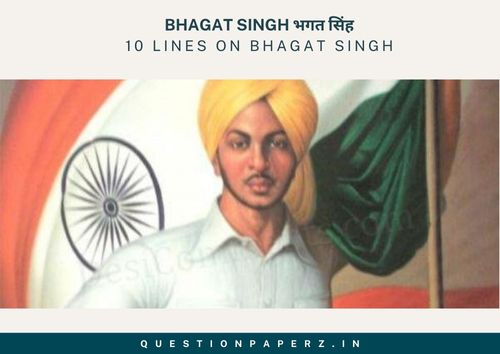Write 10 lines on Bhagat Singh. Today, I’d like to share an enlightening journey into the life and legacy of one of the most influential figures in Indian history – Bhagat Singh. As young learners, we must understand and draw inspiration from those who have shaped our world. Bhagat Singh was not just a freedom fighter but a visionary whose courage and dedication continue to inspire millions.
Contents
10 Lines on Bhagat Singh Part 1
- Early Life: Bhagat Singh was born on September 28, 1907, in Banga, Punjab, British India (now in Pakistan).
- Family Background: He hailed from a Sikh family known for its patriotism and involvement in revolutionary activities against the British Raj.
- Education: Singh received his early schooling in his village and later attended the National College in Lahore.
- Jallianwala Bagh Massacre Influence: The Jallianwala Bagh massacre in 1919 deeply impacted him and intensified his resolve to drive the British out of India.
- Joining Freedom Struggle: He joined the Hindustan Socialist Republican Association (HSRA), a revolutionary group aiming to liberate India through armed struggle.
- Protest Against Simon Commission: In 1928, Singh gained prominence by protesting against the Simon Commission, which was set up by the British without any Indian representation.
- Lala Lajpat Rai’s Death: He vowed to avenge the death of Lala Lajpat Rai, who died from injuries sustained during a police baton charge at a protest.
- Assassination of Saunders: In 1928, Singh, along with his associates, mistakenly killed J.P. Saunders, a British police officer, thinking he was the responsible police superintendent.
- Escape to Avoid Arrest: After the Saunders assassination, Singh managed to evade capture by adopting various disguises.
- Bombing in Central Legislative Assembly: In 1929, he, along with Batukeshwar Dutt, threw non-lethal bombs in the Central Legislative Assembly in Delhi to protest the Public Safety Bill.
10 Lines on Bhagat Singh Part 2
- Surrender and Trial: Following the assembly incident, Singh surrendered and was subsequently arrested and tried.
- Use of Trial for Publicity: He used the trial as a platform to publicize his cause for Indian independence.
- Hunger Strike in Jail: Singh and his fellow inmates undertook a hunger strike in jail, demanding equal rights as other British prisoners.
- Philosophy of Revolution: He was greatly influenced by Marxist ideologies and believed in a socialist revolution.
- Writings in Prison: While in prison, Singh wrote several works, including ‘Why I am an Atheist’.
- Influence of International Figures: He was inspired by figures like Lenin and admired the Irish struggle for independence.
- Opposition to Gandhian Philosophy: Singh did not agree with Gandhi’s philosophy of non-violence, advocating for direct action against the British.
- Execution: He was hanged on March 23, 1931, along with Rajguru and Sukhdev, in Lahore Jail.
- Public Reaction to Execution: His execution led to widespread national mourning and intensified the freedom struggle.
- Legacy: Bhagat Singh is remembered as a martyr and a national hero in India.
5 Lines on Bhagat Singh
- Influence on Youth: His ideals and sacrifice continue to inspire Indian youth and freedom fighters.
- Cultural Impact: He has been portrayed in various films, literature, and art, symbolizing the fight against oppression.
- Popular Slogans: He popularized the phrase “Inquilab Zindabad” (Long Live the Revolution).
- Commemoration: March 23, known as Shaheed Diwas or Martyrs’ Day, is observed in his honor.
- Enduring Symbol: Bhagat Singh remains an enduring symbol of the Indian struggle for independence and resistance against colonial rule.
भगत सिंह के बारे में 10 हिंदी पंक्तियाँ | 10 Lines on Bhagat Singh in Hindi
- भगत सिंह भारतीय स्वतंत्रता संग्राम के एक महान क्रांतिकारी थे।
- उनका जन्म 28 सितम्बर 1907 को पंजाब के बंगा गांव में हुआ था।
- वे एक ऐसे युवा थे जो देश के लिए अपने जीवन की आहुति देने को तैयार थे।
- भगत सिंह ने ब्रिटिश सरकार के खिलाफ कई क्रांतिकारी गतिविधियां कीं।
- उन्होंने हिन्दुस्तान सोशलिस्ट रिपब्लिकन एसोसिएशन की स्थापना की।
- लाहौर कांड के लिए उन्हें और उनके साथियों को फांसी की सजा सुनाई गई।
- भगत सिंह का नारा ‘इंकलाब जिंदाबाद’ आज भी लोगों को प्रेरित करता है।
- उनकी शहादत ने भारतीय युवाओं में देशभक्ति की भावना को जगाया।
- उन्हें 23 मार्च 1931 को फांसी दी गई, लेकिन उनके विचार आज भी जीवित हैं।
- भगत सिंह ना सिर्फ भारतीयों के लिए, बल्कि विश्व भर के लिए एक प्रेरणा स्रोत हैं।
Conclusion:
In conclusion, Bhagat Singh’s life was a testament to the power of youth, conviction, and the unwavering pursuit of justice. His story is not just part of Indian history but a universal tale of resistance and the struggle for freedom. As students, we have much to learn from his dedication and ideals.
I encourage you to share this list with your friends, classmates, and family. Let’s spread the knowledge of this remarkable figure, ensuring that the legacy of Bhagat Singh continues to inspire and ignite the flames of change in the hearts of future generations. Let’s remember, in the words of Bhagat Singh, “Revolution is an inalienable right of mankind. Freedom is an imperishable birthright of all.” Let’s keep the spirit of the Inquisition and revolution alive!
You can check our other 10 lines posts/articles for children and Students here. Do let us know if you have some comments and suggestions.

